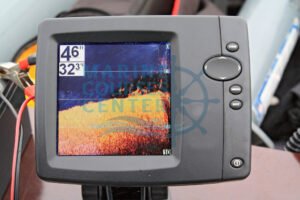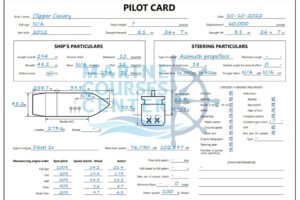
Electronic Chart Display and Information System (ECDIS) Explained
Electronic Chart Display and Information System (ECDIS) Explained
In the dynamic world of maritime navigation, technology continues to shape and redefine the ways ships traverse the oceans. Among the transformative innovations, the Electronic Chart Display and Information System (ECDIS) emerges as a vital tool that revolutionizes navigation, enhancing safety and efficiency. This article delves into the intricacies of ECDIS, its functions, benefits, and the pivotal role it plays in modern seafaring.
Table of Contents

The Evolution of Maritime Navigation ECDIS
The journey of maritime navigation has evolved from ancient techniques of celestial navigation to modern technologies that integrate satellites and digital systems. The birth of ECDIS marks a significant milestone, offering mariners a powerful means to navigate with enhanced accuracy and a reduced margin of error.
Introducing ECDIS: A Technological Marvel
ECDIS is a computer-based navigation system that employs electronic navigational charts (ENCs) to display essential maritime information. It serves as a digital counterpart to traditional paper charts, providing real-time insights into a ship’s position, course, and surrounding maritime features.
Navigational Precision: How ECDIS Works
ECDIS relies on electronic navigational charts, which are digital representations of traditional paper charts. These charts are integrated with a ship’s positioning system, allowing ECDIS to display the vessel’s precise location, movement, and course. This data fusion empowers mariners to navigate with unparalleled accuracy.
Dynamic Data Integration: Real-time Updates to ECDIS
One of ECDIS’s most significant advantages is its ability to receive real-time updates. Maritime authorities and hydrographic offices continually provide updates to electronic navigational charts, ensuring that mariners have access to the latest information about water depths, hazards, and other critical navigational details.
Advantages of ECDIS Implementation
Enhancing Safety and Reducing Risks
ECDIS significantly contributes to navigation safety by providing a clear, real-time view of a ship’s surroundings. It aids mariners in identifying potential dangers, such as shallow waters, obstacles, and collision risks. This proactive approach reduces the likelihood of accidents and maritime incidents.
Simplifying Route Planning and Monitoring
With ECDIS, route planning becomes a streamlined process. Mariners can plan optimal routes, considering factors like weather, traffic, and safety zones. Additionally, ECDIS enables continuous monitoring of the ship’s progress along the planned route, ensuring adherence to the chosen path.
Regulatory Mandates and Industry Adoption for ECDIS
Recognizing the immense benefits of ECDIS, international maritime organizations have mandated its use on certain vessels. This regulatory push has led to widespread industry adoption of ECDIS, transforming the landscape of maritime navigation.
Components of ECDIS Systems
ECDIS systems consist of several essential components:
Display Unit: Visualizing Navigation Data
The display unit presents electronic navigational charts, ship position, and relevant information in a user-friendly format. It serves as the primary interface between mariners and the ECDIS system.
Electronic Navigational Charts (ENCs)
ENCs are the digital equivalents of paper charts, containing critical information such as water depths, navigational aids, and hazards. ECDIS relies on up-to-date ENCs for accurate navigation.
Positioning Systems: Determining Accurate Location
Global Navigation Satellite Systems (GNSS) and other positioning technologies are integrated into ECDIS to determine the ship’s precise location and movement.
Alarm Systems: Ensuring Timely Alerts
ECDIS is equipped with alarms that notify mariners of potential dangers, deviations from planned routes, or approaching navigational limits.
Voyage Data Recording: Documentation and Analysis
ECDIS records voyage data, providing a valuable resource for post-voyage analysis, incident investigation, and compliance with maritime regulations.
A Future of Smart Navigation ECDIS
The trajectory of maritime navigation points toward even smarter and more integrated systems. ECDIS will continue to evolve, incorporating artificial intelligence, automation, and predictive analytics to further enhance navigation efficiency and safety.
FAQs: Demystifying ECDIS
Q1: Is ECDIS a replacement for traditional paper charts? A1: ECDIS complements traditional charts by offering real-time navigation data and enhancing navigational accuracy.
Q2: How does ECDIS improve navigation safety? A2: ECDIS provides accurate vessel positioning, early hazard detection, and route optimization, contributing to safer navigation.
Q3: Are all vessels required to use ECDIS? A3: While not mandatory for all vessels, ECDIS is required on certain vessels operating in specific regions, as mandated by international regulations.
Q4: Can ECDIS operate offline? A4: ECDIS systems require up-to-date electronic navigational charts (ENCs) and positioning data, often sourced from external databases.
Q5: What is the role of artificial intelligence in the future of ECDIS? A5: Artificial intelligence may be integrated into ECDIS systems to offer predictive insights, enhance decision-making, and automate certain navigation tasks.
What is the electronic chart display?
The electronic chart display refers to the visual representation of navigational charts on a digital screen or display unit. It is a fundamental component of the Electronic Chart Display and Information System (ECDIS), providing mariners with real-time information about their vessel’s position, surrounding maritime features, routes, and potential hazards.
What are the 3 display modes of the ECDIS?
ECDIS offers three primary display modes to cater to different navigational needs:
North-Up Mode: In this mode, the chart is oriented with the geographic north at the top. The vessel’s heading remains constant, while the chart moves beneath it as the ship changes course.
Course-Up Mode: Here, the chart aligns with the vessel’s current course. As the ship changes direction, the chart also adjusts to maintain the ship’s heading at the top of the display.
Head-Up Mode: In this mode, the chart rotates to keep the ship’s heading at the top of the display. As the vessel changes course, the chart adjusts accordingly.
What is the difference between ENC and ECDIS?
An ENC (Electronic Navigational Chart) is a digital representation of a traditional paper chart, containing essential information for navigation such as water depths, landmarks, and hazards. ECDIS (Electronic Chart Display and Information System) is the complete navigation system that utilizes ENC data to provide real-time navigation information. ECDIS not only displays ENC data but also integrates with other ship systems, offers navigational tools, and enhances navigation safety.
What is ENC in ECDIS?
In the context of ECDIS, ENC stands for Electronic Navigational Chart. It refers to the digital version of traditional paper charts used for navigation. ENCs contain critical data required for safe navigationhttps://marine-courses.com/2020/08/ship-navigation-ship-navigation-true.htmlhttps://marine-courses.com/2023/01/international-regulations-for-preventing-collisions-at-sea-colreg.htmlhttps://marine-courses.com/2023/01/international-regulations-for-preventing-collisions-at-sea-colreg.htmlhttps://marine-courses.com/2023/01/international-regulations-for-preventing-collisions-at-sea-colreg.html, such as depth contours, buoy positions, traffic separation schemes, and other navigational aids.
What are the types of display in ECDIS?
ECDIS offers several types of displays to enhance navigational awareness:
Chart Display: This mode shows the ENC data, offering information about water depths, navigational aids, and hazards.
Route Planning: In this mode, mariners can plan optimal routes, considering factors like weather, traffic, and safety zones.
Route Monitoring: Here, the system tracks the ship’s progress along the planned route, providing real-time updates about the vessel’s position and adherence to the intended path.
What are the main functions of ECDIS?
The main functions of ECDIS encompass:
Position Fixing: ECDIS accurately determines the ship’s position using satellite navigation systems and displays it on the electronic chart.
Navigation Planning: Mariners can plan routes, set waypoints, and calculate Estimated Time of Arrival (ETA) using ECDIS.
Collision Avoidance: ECDIS aids in identifying potential collision risks by displaying the positions of other vessels and navigational hazards.
Route Optimization: The system suggests the most efficient and safe routes, factoring in various variables such as weather, traffic, and draft.
Real-time Updates: ECDIS receives real-time updates about chart corrections, ensuring that mariners have the latest navigational information.
Alarm Systems: The system generates alarms for proximity to hazards, deviations from planned routes, and other critical situations.
Voyage Data Recording: ECDIS records voyage data, which can be used for post-voyage analysis, incident investigations, and regulatory compliance.
What is the function of electronic chart system?
The primary function of an electronic chart system is to provide mariners with accurate and up-to-date navigational information in a digital format. This system displays electronic navigational charts (ENCs) on a screen, enabling mariners to navigate with precision. It offers features such as real-time positioning, route planning, collision avoidance, and continuous monitoring of a vessel’s progress. The electronic chart system enhances navigation safety, efficiency, and situational awareness for mariners.
What is the function of display scale in ECDIS?
The display scale in ECDIS determines the level of detail shown on the electronic chart. By adjusting the display scale, mariners can choose to view a broader area with less detail or zoom in to see a specific region with more detail. This function allows mariners to tailor the chart’s information to their navigational needs, whether it’s for strategic planning or precise maneuvering in confined waters.
What is the difference between ECDIS and ECS?
ECDIS (Electronic Chart Display and Information System) and ECS (Electronic Chart System) are related but distinct systems used for maritime navigation:
ECDIS: ECDIS is a comprehensive navigation system that uses electronic navigational charts (ENCs) to display real-time navigation data. It meets international standards and regulations, making it suitable for primary navigation on certain vessels.
ECS: An ECS, or Electronic Chart System, is a navigation aid that displays electronic charts but does not necessarily meet the stringent standards required for primary navigation. ECS systems are often used as supplementary tools for navigation, route planning, and situational awareness.
How do you make an electronic chart?
Creating an electronic chart involves several steps:
Surveying and Data Collection: Hydrographic surveys are conducted to gather data about water depths, navigational aids, shorelines, and other relevant features.
Data Processing: The collected data is processed and transformed into a digital format compatible with electronic chart systems.
Chart Compilation: Using specialized software, the processed data is used to compile electronic navigational charts (ENCs). These charts adhere to international standards and include various layers of information.
Verification and Correction: ENCs undergo thorough verification and correction processes to ensure accuracy. Corrections are continually made based on updated information.
Distribution: The finalized ENCs are distributed to mariners and vessels through official channels. Mariners can then load these charts into their electronic chart systems for navigation.
if you want to find ship position join marine traffic website
Leave A Reply
You must be logged in to post a comment.




3 Comments
Hello i want to ask questions. Whene you have two ecdis units how do you do encs update with or without synchronization?
Thank you for your question it will be different according to types of ECDIS